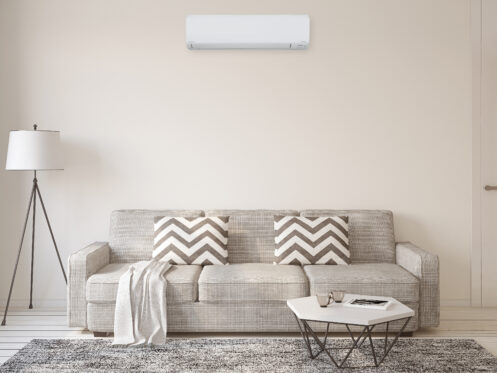Are you considering adding a ductless mini-split system to your home? Ductless mini-splits can be extremely useful in certain situations. This type of system is a good choice if you need to supplement your air conditioning or want to add AC to a room that isn’t connected to your central HVAC system.
If you choose a system that has a heat pump instead of a standard AC condenser, it will also provide heating in the winter. While mini-splits can be handy, there are some limitations that mean they may not be suitable for all rooms or situations. This article will explain all you need to know about mini-splits and where they can and cannot be used.
Parts of a Ductless Mini-Split System
Ductless mini-splits have two primary components—an AC condenser or heat pump that is installed outside and an air handler or head that is mounted inside the building. Some mini-splits are single-zone systems with just one air handler, and there are also multi-zone systems that can have anywhere between two and eight air handlers.
Limitations When Installing a Ductless Mini-Split
With either a single-zone or multi-zone mini-split system, you can usually install an air handler in almost any room if your home isn’t all that large. However, it can depend in large part on where the outdoor unit is installed. The reason is that the AC condenser or heat pump is only so powerful and can only move the refrigerant over a certain distance.
Most single-zone systems require the air handler to be within 75-100 feet of the outdoor unit. Multi-zone systems have larger, more powerful outdoor units and can usually pump the refrigerant to a distance of up to 150 feet. This limitation is why it would sometimes be necessary to install two separate systems if you wanted to use a mini-split to cool and heat all of a larger home.
Another thing to consider is that the air handlers should ideally be mounted on an exterior wall or in the ceiling near an exterior wall. You could possibly install an air handler in a room that doesn’t have any exterior walls as long as it isn’t too far away from the outdoor unit. However, it would make the installation more complicated. In this case, the refrigerant lines that connect the air handler to the outdoor unit would usually need to be run in the attic. They could also be underneath the floor in the basement or crawl space.
If the room has an exterior wall, all it takes is to run the refrigerant lines along the outside of the house. Then they would go through a hole in the exterior wall wherever the air handler will be mounted. This obviously makes the installation process much simpler and also helps to minimize the distance between the indoor and outdoor components.
Best Places to Use a Mini-Split System
A mini-split system could be used to heat and cool an entire home that doesn’t have an existing central HVAC system. Some people are also choosing to install one or more mini-splits instead of a central HVAC system when building a new home. Nonetheless, mini-splits are more commonly used to provide supplementary heating and air conditioning. For instance, you might have a room with lots of windows or a part of your home that is typically too warm in summer and too cool in winter. If so, installing a mini-split is an easy way to overcome these issues and make it more comfortable.
Installing a mini-split is also an ideal solution if you want to add heating and air conditioning to your garage. Garages should generally never be connected to a central HVAC system. Doing so would be a major safety hazard since it could result in the exhaust fumes from your vehicle getting drawn into the other parts of your house.
A mini-split is also typically the best, most cost-effective choice if you are putting an addition onto your home unless you need to replace or upgrade your existing HVAC system. Connecting the addition to your existing HVAC system would be quite expensive since you’d need to have additional ductwork installed. Still, the bigger issue in this regard is that it would likely lead to your heating and air conditioning no longer being effective enough to keep your home sufficiently comfortable.
The reason is that your existing HVAC system was sized based on the current square footage of your house. Adding onto your house obviously increases the square footage, which means you would likely need a larger furnace and AC or heat pump. The only exception is if the addition is quite small and your existing HVAC units are slightly oversized.
Your Trusted HVAC Professionals
As the leading HVAC company in Longmont, Mead and Northern Colorado, My Guy Heating and Air, LLC is ready to take care of your heating and air conditioning installation needs. We install ductless mini-splits as well as central HVAC units, and our team can help you determine if a mini-split is right for your home. We also offer professional HVAC repairs and maintenance so give us a call today if you need any home comfort service.




